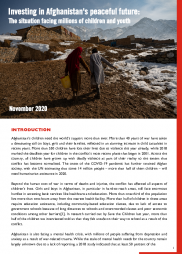
Investing in Afghanistan’s Peaceful Future: The situation facing millions of children and youths
Publication year:
2020
English
Format:
pdf (42.2 MiB)
Publisher:
Save the Children Afghanistan
On 23-24 November 2020, donor countries, the Government of Afghanistan, civil society and other key stakeholders will gather in Geneva and online for the 2020 Afghanistan Conference. This is a crucial moment for Afghanistan that will determine much of the country’s financial future.
Afghanistan has seen much progress in the last two decades since the most recent phase of the conflict started in 2001. Afghans live longer and healthier lives, millions of more children – in particular girls – have access to education, and women participate in all aspects of public life. Despite this, enormous challenges remain.
This briefing from Save the Children outlines some of the key issues still facing millions of children in the country. The UN estimates that some 14 million people (close to 40 percent of the population) will be in need of humanitarian assistance in 2020, including 7.4 million children. Despite the growing needs, funding for the UN’s annual humanitarian appeals has dropped in recent years. The conflict also continues to take a disproportionate toll on children, with close to 1,900 children killed or maimed just in the first nine months of 2020. The war has affected all aspects of children’s lives, and created a whole generation that is mentally scarred from the violence.
Even before the pandemic, more than 3.7 million children were out of school, 2.6 million of them girls. The reasons for this include damaged schools, insufficient learning resources or classrooms, a lack of teachers, or the long distances some children have to travel to reach school, amongst other barriers.
This briefing includes key recommendations for international donor governments and the Government of Afghanistan on how to use to Conference to build a better and safer future for all Afghans. Save the Children urges donors to invest in education with a particular focus on girls’ access to schooling, on quality healthcare, and to ensure that child protection is prioritised and mainstreamed across all interventions.
Read full abstract
Authors
View & Download
Document information
Publisher
Authors
Format
Country
Region
Rights
© Author/Publisher
Found a mistake? Help us improve!
If you have noticed a document assigned to the wrong author or any other inaccuracies, let us know! Your feedback helps us keep our data accurate and useful for everyone.
Share
Link
